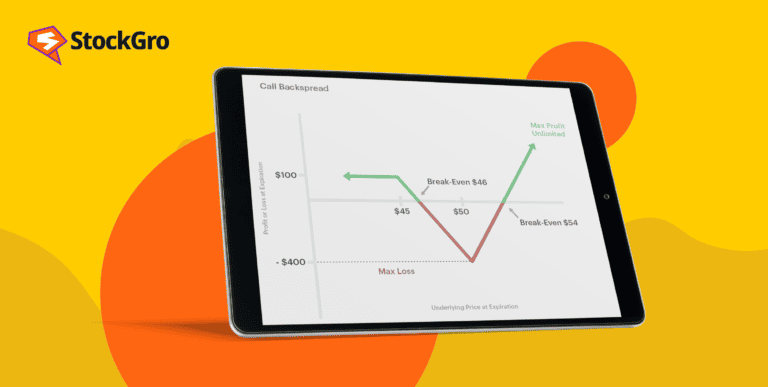
Options trading is a clever tool traders use to get more out of their market trading. And among the different strategies in options trading, there’s one called the “fiduciary call strategy.” It’s a smart way to trade that helps you handle risks while having a chance to make some gains.
What is a fiduciary call?
The fiduciary call strategy involves two primary components: buying a call option and simultaneously setting aside enough cash to cover the potential exercise of that option. This approach is rooted in risk management and serves as a protective measure to limit potential losses.
Also read: How to trade in options and maximise your profit?
Fiduciary call example :
An investor is looking to purchase 100 shares of ABC Corporation. Its share is trading at Rs.500 per share at the moment. The investor believes that the stock has the potential to appreciate shortly but is concerned about short-term market fluctuations.
To protect against potential downside risk while participating in any price appreciation, the investor decides to execute a fiduciary call strategy.
The investor buys a call for 100 shares of ABC Corporation. The strike price is at Rs.550 per share. Simultaneously, the investor invests an equivalent amount of money in a risk-free asset, such as a government bond or a fixed deposit with a face value of Rs.55,000 (100 shares x Rs.550 per share).
The investor has created a protective position using the fiduciary call deposit strategy.
Imagine a situation where the price of ABC Corporation’s stock price rises above Rs.550 on or before expiry. The investor can then exercise the option at the strike price and buy the shares at a lower price, realising a profit.
On the other hand, if the stock’s price falls or remains below Rs.550 per share, the investor’s loss is limited to the premium paid for the call option, as the risk-free bond investment serves as a hedge.
Fiduciary call formula
The formula for calculating the profit or loss from a fiduciary call position depends on the specific details of the call option and the risk-free asset involved.
Here is a formula to calculate the return from a fiduciary call:
Profit/ loss = (stock price at expiration - strike price of call option) - premium paid for call option + interest earned from risk-free asset
In this formula:
The stock price at expiration is the price of the underlying stock at the expiration date of the call option.
The strike price of the call option is the price at which the investor has the right to buy the stock.
The premium paid-for-a-call option is the cost of buying the call option.
Interest earned from a risk-free asset is the interest income earned from the risk-free asset over the same period.
Also read: Option chain for smarter online trading
Fiduciary call and protective put
A fiduciary call and a protective put are two distinct strategies, but they share similarities in their risk management objectives. Both strategies aim to protect an investor’s capital while allowing them to participate in potential price gains.
A protective put strategy entails purchasing a put option for a stock that an investor currently holds in their portfolio. This put option grants the trader the right to sell the stock at the strike price, offering a safeguard against potential losses, in case the stock’s value declines.
In exchange for this protection, the investor incurs a premium cost for the put option similar to the premium paid for a call option in a fiduciary call approach.
The difference between a fiduciary call and a protective put is in the choice of options:
- In a fiduciary call, an investor buys a call option and invests in a risk-free asset.
- In the protective put strategy, a trader buys a put option on a share they already own.
- Both strategies protect against downside risk, but the fiduciary call allows investors to maintain exposure to an asset they do not own.
Advantages of using the fiduciary call strategy:
Saves money
When you use the fiduciary call strategy, you do not have to buy any shares until the contract ends. This means you will not be losing before you know the strategy’s outcome.
Lower starting cost
Starting the fiduciary call strategy requires less money upfront compared to other methods.
Easy to use
You don’t need fancy software or complicated technology for fiduciary call strategies. They’re simple and accessible for regular investors. It’s a simple choice for fresh traders and investors who want to try their hand at options trading.
Also read: Futures vs. Options: Differences every investor must know!
Key considerations when using the fiduciary call strategy
When you’re implementing the fiduciary call strategy, you should consider important factors that influence both risk and reward:
Premium costs and timing of entry
A key factor you must consider when using a fiduciary call strategy is the cost of the call option, referred to as the premium. The cost of the premium will impact your overall profit. A higher premium will mean that you need a larger price increase in the stock in order to gain profits.
Timing plays a very important role here. You need to assess when to buy the option, as market volatility or changing interest rates can significantly affect option prices. Entering the market when there is low volatility can lower premium costs and make the strategy more cost-effective.
Strike price selection
You must also select an appropriate strike price. The strike price will determine the level at which the option can be exercised, and selecting a strike price too far from the current stock price may lower the premium but reduce the chances of the option being profitable.
On the other hand, if you select an in-the-money strike price, it will increase the chance of profit but come with a higher premium. It is essential to balance these trade-offs to adjust the strategy as per your risk tolerance and goals.
Interest rate on the risk-free asset
In a fiduciary call strategy, you set aside funds in a risk-free asset like a government bond or fixed deposit. The return on this asset provides additional income and helps even out the premium cost of the call option. The higher the interest rate on the risk-free asset, the more it can contribute to minimising your overall cost.
However, the return on these assets may be negligible when the interest rates are low. This can make it less effective compared to a risk hedge. As a trader, you should assess the current interest rates before locking in funds.
Market conditions and stock volatility
It is vital to understand market conditions and the volatility of the underlying stock when you’re deciding whether you want to use the fiduciary call strategy. In a high-volatility market, option premiums may be more expensive, but the potential for price swings increases, offering higher upside.
But in a low-volatility market, while premiums can be cheaper, the stock’s movement may be too limited to make the strategy worthwhile. Assessing volatility will allow you to time your trades more effectively.
The expiration date of the option
The call option’s expiration date is another factor that you need to consider. A longer expiration date will give the stock more time to appreciate and increase the chance of a good outcome. However, longer-term options also tend to come with higher premiums.
A shorter expiration date will come with a lower premium cost but also limit the potential upside as the stock will have less time to appreciate. You should balance these factors based on their market outlook.
Conclusion
A fiduciary call is a powerful tool that allows investors to protect their capital while participating in the potential upside of an asset. By combining call options with risk-free assets, investors can manage risk effectively and make informed investment decisions.
Understanding the concept of fiduciary call is essential as these strategies can help individuals and institutions alike achieve their financial goals while minimising risks in an ever-changing market environment. Want to achieve financial freedom? Here is a comprehensive guide to teach you about how to be financially free and finanical independence.

